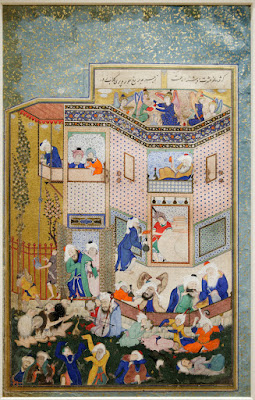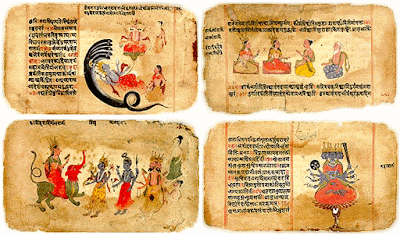Vedic Education - Aims, Salient features, Special reference to Curriculum and Method of teaching.
(Worldly and Other Worldly)
'This Worldly' dealt with the social aspect whether the 'Other Worldly' related to intellectual pursuits for achieving salvation.
However the greater Emphasis was laid on the letter, because education was considered as the mean of free from life bondages.
SYSTEM OF EDUCATION DURING VEDIC PERIOD
The system of education during the vedic period was totally different from Today's education system. The student life in vedic period was began with Upanayana ceremony. This was performed for 3 days. And the students go to this chosen teacher, called as Acharya.
(Upanayana or Thread Ceremony)
The place of learning was called Gurukul and after the Upanayana ceremony the pupils was called as Brahmachari.
The home of the teacher or Acharya was the centre of learning, which was situated in natural surrounding. The age limit of upanayan was 8 years, 11 years and 12 years respectively for Brahmins, Kshatriya and Vaishyas.
But the learning process was almost dominated by the Brahmins. At the time passed the other two castes Katriya and Vaishyas entered to receive education but the Shudra castle's people were denied to study the holy scripture.
AIM OF EDUCATION DURING VEDIC PERIOD
The following are the aims of education in vedic period :-
- The aim of Vedic education was to realise the supreme and achieve the supreme consciousness.
- Inculcation of spirit of piety and righteousness was the aim of education.
- Preservation and spread of ancient culture was the aim of ancient education system.
- The Chief aim was To unfold The Spiritual and moral power of the individual during Vedic period.
- The objective of education were perfection of physical mental and intellectual personality of the student.
- Formation of good and moral character was also another aim of Vedic education.
- Inculcation of social and civil duties was one of the Aims in vedic period which was necessary for a better future life.
- For the development of Vocational efficiency healthy positive attitude and dignity of labour were fostered in pupils during Vedic period.
SALIENT POINTS OF VEDIC SYSTEM OF EDUCATION
- The ancient Indian education emerged from the Vedas as they were the main sources of Indian philosophy of life.
- The attitude of people towards life was intellectual and spiritual, rather than materialistic. Their objective was to attain salvation through education and that to through religious education.
- Indian culture surcharged with religious feelings and it was assigned prominent place in the field of education.
- The forest home of the preceptor in the midst of charming, natural surrounding served as the educational institution where the pupil lived after the Upanayana or initiation ceremony. The preceptor occupied the place of the father or guardian and was discharging the duties by shouldering the responsibility of his ward's maintenance. Much emphasis was laid on the formation of character though ‘plain living and high thinking’ .
- The basis of admission was moral fitness and unimpeachable conduct. The pupils belonging to a lower order of moral conduct was forbidden to live in the house of the preceptor.
- The discipline of Brahmacharya or Celibacy was compulsory for all. Education helped in the observance of celibacy, control over senses and purity of life.
- To serve the preceptor was considered as the sacred duty by the pupils. Being a residential pupils he was looking to the comforts of the Guru. In thought, speech and deed he pledged devotion to his Guru.
- The practical aspect of life was not lost of sight. Side by side with art, literature, and philosophy students were getting working knowledge in agriculture and other vocations of life.
- Individual was the teaching unit and all round development of the child's personality was the chief aim of education. The method of teaching was psychological in nature.
CURRICULUM DURING VEDIC SYSTEM OF EDUCATION
The curriculum during Vedic period was dominated by the teaching of Vedas and Vedic literature, spiritual and moral lessons. The other subject like philosophy, astrology, logic, language, grammar were teaching during Vedic period.
Also physical education was included in the curriculum student were learned archery, wrestling, hunting, dancing, etc. Some professional and Technical Education like astronomy, chikisha, Ayurveda, arthasastra were the student learned in the curriculum.
METHOD OF TEACHING DURING VEDIC SYSTEM OF EDUCATION
There were mainly three steps of learning according to Vedic system. Sravana is the first step. It means listening towards the text as uttered by the teacher. By this method of education, knowledge was conserved and transmitted to the on coming generation. The second step was Manana . It means to internalize or to assimilate what was given to the pupils. It is the process of deliberation and Reflection on the topic. The third step was Nididhyasana ( Meditation ) by who is truth is realised and attended. It was considered in indispensable for the realisation of Supreme reality.
The ancient system of teaching was listening (Shruti) . Perception was direct method of learning, lecture, dialogue, debate, discussion, question-answer,etc were adopted as method of teaching.
--------------------------------------------------------------------------------------------------------------------
This article is related to the following topics -
salient features of vedic education
education during vedic period
aims of vedic education
education in vedic period
vedic system of education
curriculum of vedic education
vedic period education
vedic education system
vedic education
merits and demerits of vedic education
vedic education b ed notes
vedic education wikipedia
characteristics of vedic education
what is vedic education
role of teacher in vedic education
vedic education ppt
gurukul system of education in vedic period
vedic period ppt
gurukul system of education ppt
what were the features of education system in ancient india
Education system of India









Nice answer sir
ReplyDeleteSir i want more answer from different questions
Very well explained
ReplyDeleteExceptional answer best understand
ReplyDeleteBut hindi words can't remember
Sir I wants more answers of salient features
ReplyDeleteHelpful
ReplyDeletethank u so much
ReplyDeletebhai kis language me hoti thi
ReplyDeletesanskrit
DeleteGood explanation sir
ReplyDeleteSir i want complete detail about this topic like features of vedic education, scope of education, period of education, educational institution curriculum, methods of teaching, teacher, teacher pupil relationship and the last one is conclusion.....
ReplyDeleteHelpful
ReplyDeleteI want more explained for features ... merits and demerits of vedic education
ReplyDeleteNot bad
ReplyDeleteYou're an amazing teacher and we're so grateful to have you
ReplyDeleteThank you so much ❣️
Hmm
DeleteWho said shudras were denied of education? Do your research before you write something on the education system of the most vast civilization. Do you even know varnas are not the part of Vedas? The Guru would give varna based on the flavour or personality of their Students. It was dependent on the family where He or she has taken birth. And Brahmacharya was an Ashram/Awastha as student till you complete your education. The way you have described it clearly seems that you have no understanding of the difference between Brahmacharya and Sanyas. Understand it yourself before you try to "impart" your vast knowledge upon others
ReplyDelete*not dependent upon the family he or she has taken birth.
ReplyDelete